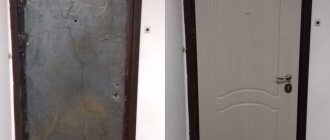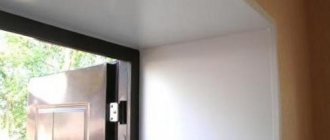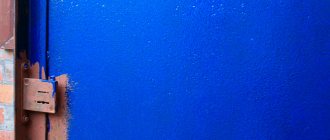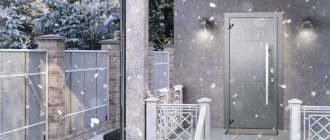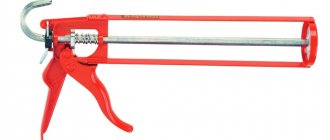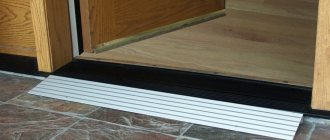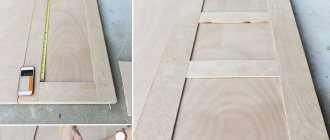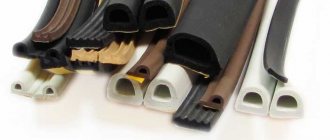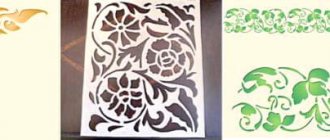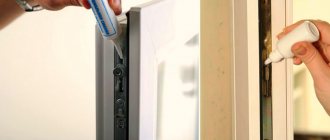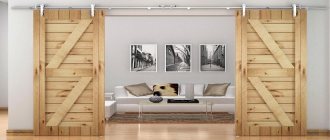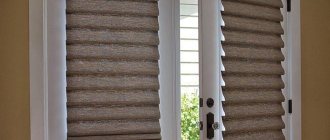The entrance door to an apartment or private residential building is part of the enclosing structure, which is why it is subject to increased requirements for burglary resistance, heat and sound insulation. In addition, the interior side of the structure must be combined with the overall style of decoration of the hall or hallway. Many companies offer ready-made decorative finishes for this structural element. If the owner of the premises does not have the opportunity to purchase a complete product, he needs to know how to decorate the front door from the inside with his own hands.
Inner side of the front door
The most popular methods for decorating the front door from the inside
When decorating the interior, designers recommend that customers use the following technologies for finishing the inner surface of the front door:
- Coating a steel sheet, plywood or OSB with a paint and varnish composition in a single color scheme, or with a shagreen effect. Most often, manufacturers use the principle of hammer painting with special pigment substances for metal, as they increase the corrosion resistance of the material and give a decent appearance to the surface.
Plywood door covering
- Upholstery of the inside of the door with leather or substitutes for natural materials with padding of the internal space with elastic inserts, for example, batting. This finishing option significantly increases the heat transfer resistance of the enclosing structure.
Carriage tie
- Interior cladding made of rigid panels - MDF, chipboard, plywood with textured color lamination. Materials can be combined with various inserts, including mirrors and steel overlays, which is especially important for high-tech interiors.
Door with MDF panel
- In many hardware stores you can find polymer stickers that are fixed to the smooth and grease-free surface of the door, creating the illusion of a beautiful landscape and other interesting images.
Stickers on the front door
When finishing an exclusive interior, designers also often personally decorate the front door, resorting to the technique of aging wood, brushing or decoupage. As a result of many hours of work, the result is an interesting vintage interior, or a pronounced “country” style.
Application of brushing technology
Door threshold design options
When finishing entrance door structures, special attention is paid to the manufacture and design of thresholds, since this element is subject to the greatest physical stress.
The design of many door block models already includes a ready-made threshold. But there are also options without such an element. In this case, finishing the threshold of a wooden or metal entrance door from the inside is done independently.
To make it, it is important first of all to select a sufficiently strong and reliable material.
Wooden
Most often, homeowners install wooden thresholds in their entrance openings. But this is a fairly soft material that wears out quickly with intense physical impact.
Paint is often used to cover such thresholds; less often they are sheathed with laminate or other wood panels.
Concrete
Concrete thresholds, as a rule, are erected during the construction of buildings, or owners of private houses equip them themselves when installing new door blocks.
Such thresholds are characterized by increased strength. For their finishing, laminate, tile, and other wooden coverings are used.
Disadvantage - during operation under significant mechanical loads, concrete may chip, and accordingly the structure will have to be redone.
Metal
Steel products are the most durable, reliable and durable. They are not afraid of increased mechanical loads. Throughout the entire period of operation they do not lose their original appearance. If the structure is additionally coated with paint, it will need to be updated periodically.
Finishing the front door and door threshold inside the apartment does not require special knowledge and skills; repair work can be completely planned and carried out with your own hands.
Source
The most commonly used materials for finishing the inside of the door
The methods listed above allow you to realize any designer’s idea, provided the following materials are available:
- Natural wood of valuable species - oak, walnut, beech, and ash.
Natural wood paneling
- Boards made of natural coniferous materials - pine, cedar.
Pine paneling
- Genuine leather for carriage screed.
Covering with genuine leather
- Leatherette for soft upholstery.
Leatherette upholstery
- Ready-made MDF panels.
MDF panel in assortment
- Chipboard or OSB sheets, moisture-resistant plywood.
OSB sheets for the door
- Laminated film.
Film sticker
- Nitro paints, alkyd, acrylic, hammer, oil or other paints and varnishes.
Dyed canvas
- Carpeting, laminate and other materials used as floor finishing.
Laminate as a finishing material
Large factories that supply doors of modular dimensions, or on individual orders from premises owners, usually use the technology of constructing MDF panels with high-quality lamination. Modern materials in this category are characterized by increased wear resistance, durability, and are resistant to mechanical damage and temperature changes.
Factory for the production of entrance doors
Colors
Slopes are a small detail that can either support the style in the interior or completely break out of it.
An inappropriate color of decoration will become an element that violates the integrity of the overall picture, so it is important to choose the right color in accordance with the design of the door and the decoration of the walls, floor and ceiling in indoors
The color of the slopes directly depends on the selected material:
Tree and its derivatives. This group includes all materials in the production of which wood was used in one way or another. These include classic solid wood panels, lining, and all slabs pressed from chips and adhesives, veneer, and laminate. Accordingly, the color palette is varied, but does not go beyond natural colors: pine, spruce, poplar, ash, bleached oak, stained oak, pink oak, light walnut, medium walnut, dark walnut, red maple, mahogany, antique pine, Douglas . Chic colors are collected in a dark palette of natural and synthetic origin: cherry, mahogany, wenge, chocolate, teak, Indiana, Macassar, Locarno apple.
How to paint the inside of your front door yourself
To paint a door with your own hands, a home craftsman will not need special skills or complex professional tools. At the same time, the finishing materials market offers many options for paints with different compositions and shades intended for painting metal, wood, plastic and other surfaces.
Paints for processing metal doors
This type of finishing of the interior side of the door has many undeniable advantages:
- First of all, painting is the cheapest finishing option, and, compared to other types of decor, it does not require the purchase of a large number of high-quality materials.
Metal processing with primer
- To apply an even layer, you only need a paint composition from a trusted manufacturer, as well as a high-quality brush. The simplicity of this solution eliminates the need to turn to expensive professionals to complete the work. Painting can be done by any home craftsman, regardless of age, gender and experience.
Tool for painting door panels
- Various color options in a matte finish or with a glossy finish are widely available, as well as textured paints, which make it easy to create an original surface stylized as natural wood or stone.
Textured hammer paint
- The possibility of combining different colors, as well as creating patterns or ornaments on the surface of the interior side of the door.
Drawings on the front door
To paint the entrance door leaf with your own hands, you should stock up on simple painting tools, solvent or other degreaser, paint, and carry out all work according to the following flow chart:
- All fittings that could interfere with painting - handles, locks, peepholes - are removed from the canvas.
Removing the handle
- The surface is cleaned of the old coating, after which it is polished with abrasive disk attachments on an electric drill.
Surface cleaning
- After cleaning, the inside of the door is swept and degreased with a solvent or alcohol-containing liquid.
Surface degreasing
- A protective film is glued around the perimeter of the door, as well as on the floor, to protect finishing materials from paint.
Sticker of protective materials
- The surface of the door is primed with a protective compound, which simultaneously prevents the metal from corrosion and promotes better adhesion of the material.
Corrosion protection
- On the primed surface, after the protective composition has dried, paint is applied in an even layer in one direction. The best solution is to move a roller or brush along the long side of the door leaf.
Painting a metal surface
- If it is necessary to apply two or more layers, wait time for the composition to polymerize, after which the procedure is repeated.
Waiting for polymerization
- After applying the last layer, in order not to damage the freshly painted surface, during the next 24 hours you should operate the door with extreme caution, avoiding contact with the interior surface.
Door operation
When painting a door, you should make sure in advance that each layer is applied evenly, because after the substance has polymerized, it is almost impossible to restore an unpainted surface without a trace.
Evenly applied layer
Features of finishing for different walls
The technology for finishing a doorway depends on the type of wall and the material from which it is made. This approach is explained by the different sizes and properties of the base. Possible options:
- concrete and reinforced concrete;
- brickwork;
- cinder block and other types of blocks;
- glued or rounded timber;
- sandwich panels.
The easiest way to install the finish is on a concrete wall, because it is strong, dense in structure, has a small thickness and is not destroyed by hand tools. The brickwork is distinguished by a wide partition measuring up to 50–60 cm, so standard expansion is not used. You should work with bricks carefully, because they can crack under mechanical stress.
A wall made of cinder blocks has a lower density than a concrete one and requires gentle handling when installing the finish. For example, replace self-tapping screws with polyurethane foam. This also applies to other materials with low density - foam and aerated concrete, sandwich panels.
How to do door trim yourself
Another popular way to improve the front door is to upholster the door with leather, leatherette with a soft filler. Such a surface provides comfort, helps retain heat, prevents the spread of vibration, is easy to clean and lasts for decades, subject to careful handling.
Door upholstery in the interior
To do the door upholstery with your own hands, you need to buy fabric or eco-leather in a textile and hardware store, filler - batting, as well as a set of decorative nails with wire for installing a screed.
Upholstery set
When installing soft door trim, the home master must sequentially perform the following algorithm:
- Similar to the previous method, handles and other fittings are removed from the surface.
Door upholstery nails
- Before starting work, the door must be dismantled from the hinge hangers and carefully laid on a flat horizontal surface. Considering the large weight of the metal product, it is better to do this work together.
Leatherette and batting for upholstery
- All elements of the old finish are removed from the inside of the canvas, the surface is brought to a smooth state and degreased with white spirit.
Applying glue
- The plane of the upcoming finishing is treated with an adhesive compound - glue based on epoxy resin or silicone sealant, after which the soft filler is carefully laid out on it, in an even layer, without the formation of empty areas.
Gluing the filler
- The upholstery material is carefully applied to the surface of the canvas so that there are overhangs of equal size on each side.
- Consistently, using quick-drying glue, the edges are folded and fixed along the entire perimeter of the door, with force. As a result, you should get a uniform, moderately stretched surface, without folds or bends.
- Excess material around the perimeter of the canvas is trimmed with scissors or a construction knife.
Leatherette sticker
- At the location of the peephole and locks, the material is cut out with a knife, and the edges are carefully glued to the plane of the door.
- If heat-insulating rollers are supplied with the upholstery material, they are also fixed with glue around the perimeter of the product.
- At the final stage, a tie is made of wire and decorative nails on the surface of the door.
- The drawing should be drawn in advance with a pencil on the surface of the material, and then installation of the screed should begin.
Screed device
When the screed is completed, it is recommended to check the reliability of compliance with each mating line, then install the canvas in place and re-mount the fittings.
How to properly decoupage the front door
Creative painstaking work that turns the door into a decorative element of any interior. The entire operation takes a whole day, depending on the complexity of the design, and is performed in compliance with the following nuances:
- As in all previous options, all fittings are removed from the door, after which the door leaf is removed from the hinges.
- The surface is cleaned of the old finishing coating and sanded until a smooth surface and a metallic shine are achieved.
- The entire inside of the door is degreased with special paint chemicals.
Decoupage doors in the interior
- The owner of the premises initially purchases stickers made of polymer film, which can be installed entirely or different elements for appliqué can be cut out of them, according to a previously developed sketch.
Material for decoupage
- To glue decorative elements, you will need PVA glue, which is first diluted in clean warm water.
- Before sticking the pictures, you should first outline them on the surface of the door with a simple pencil.
Outlining drawings
- Each element of the applique is carefully treated with glue, pressed against the surface, smoothed and pressed for a few seconds.
Applique sticker
- When the adhesive composition polymerizes, the surface of the material should be coated with high-quality varnish, which will smooth out all irregularities and reliably protect the product from destruction.
This method of decoration will not only improve the door at minimal cost. The material, coated with varnish, is reliable and durable, resistant to scratches, and can be easily wet cleaned. The only drawback of the technique is the need to contact artists or designers, since not every average person will be able to perform such creative work.
Plasterboard slopes
It is impossible to simply make slopes using drywall. This material is the basis for subsequent installation. Before fixing it, the wall surface is primed and leveled.
When installing an iron structure, first the primer is dried. While it dries, the necessary measurements are taken and the sheet material is cut. Measurements must be taken carefully, as the opening may have a slope, and the part will need to be cut at some angle.
You can outsource such work to a specialist, but this will require financial costs. Therefore, in order to save money, many do this work themselves.
The platbands, together with the trim, are attached with dowels or special glue. Today glue has gained popularity. Before finishing begins, the side panels are installed first, followed by the top trim.
The technique of finishing with glue is simple. It is applied in the form of cakes with a step of 10-15 cm. It can also be applied in a continuous layer. To obtain even corners, use a special perforated corner.
Technique for finishing an opening with plasterboard
Briefly about the main thing
To improve the interior of your front door, you don’t have to spend a lot of money and turn to professionals. Every home craftsman, with basic experience in finishing work and a set of standard tools, can do all the work with his own hands. The most popular types of finishing are painting, upholstery, carriage binding, hard paneling and decoupage. For each type of decor, preparatory work should be carried out and all points of the technological map must be consistently completed.
Wood paneling
Solid wood is considered the most expensive material for cladding entrance doors. As a rule, it is used to decorate metal structures not only from the inside, but also from the outside. Wooden panels with carved or scorched patterns, as well as milled finishes, look very beautiful.
Noble wood adds elegance and style to even the simplest door panels, makes the entrance to a home unique and speaks of the high status of its owners. The original texture of the material and exquisite decorative elements make the door the center of external or internal design. The combination of wood and metal looks unique and beautiful, so you can add forged parts and fancy fittings to the cladding.
